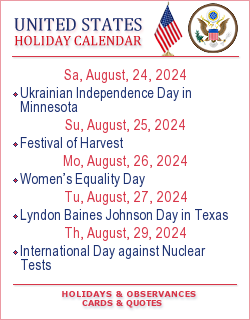For many Americans, every day is a day of prayer. More than half (55%) of Americans say they pray every day, according to a 2014 Pew Research Center survey, while 21% say they pray weekly or monthly and 23% say they seldom or never pray. Even among those who are religiously unaffiliated, 20% say they pray daily. Women (64%) are more likely than men (46%) to pray every day. And Americans ages 65 and older are far more likely than adults under 30 to say they pray daily (65% vs. 41%). A Pew Research Center survey conducted in 2014 found that 45% of Americans – and a majority of Christians (55%) – say they rely a lot on prayer and personal religious reflection when making major life decisions. The same survey found that 63% of Christians in the U.S. say praying regularly is an essential part of their Christian identity.
The modern law formalizing its annual observance was enacted in 1952 by the Congress and President Harry S. Truman, although earlier days of fasting and prayer had been established by the Second Continental Congress from 1775 until 1783, and by President John Adams in 1798 and 1799. Most presidents have issued annual or special occasion proclamations for a national day of prayer, with the notable exception of Andrew Jackson. Thomas Jefferson also issued a day of prayer and thanksgiving, but this occurred while serving as governor of Virginia.
As with the addition of “under God” to the Pledge of Allegiance in 1954, the move came during the Cold War and was seen as a way of contrasting the more religious United States with the officially atheistic Soviet Union.
The National Day of Prayer (36 U.S.C. § 119) is an annual day of observance held on the first Thursday of May, designated by the United States Congress, when people are asked "to turn to God in prayer and meditation". Each year since its inception, the president has signed a proclamation, encouraging all Americans to pray on this day.
The National Day of Prayer is celebrated by Americans of many religions, including Christians of many denominations, including Protestants and Catholics, as well as Sikhs, Muslims, Hindus, and Jews, reflecting the demographics of the United States. On the National Day of Prayer, many Americans assemble in prayer in front of courthouses, as well as in houses of worship, such as churches, mosques, synagogues, and temples. Luncheons, picnics, and music performances revolving around praying for the nation are also popular observances. Traditionally, the President of the United States issues an official National Day of Prayer proclamation each year as well.
The Freedom From Religion Foundation unsuccessfully challenged the National Day of Prayer in court. The 7th Circuit Court of Appeals ruled in 2011 that the group, which aims to promote the separation of church and state, did not have legal standing to challenge the law.
In 2014 – in the case Town of Greece v. Galloway – the Supreme Court ruled that U.S. legislative and administrative bodies may begin their sessions with a prayer. On some occasions, however, the high court has rejected other types of state-sponsored prayer. For instance, in 1962’s Engel v. Vitale, the court famously struck down a policy requiring public school students to begin their day with a nonsectarian prayer.
Source: wikipedia.org | state.gov | pewresearch.org
In 2025 National Day of Prayer in USA falls on May 1.



